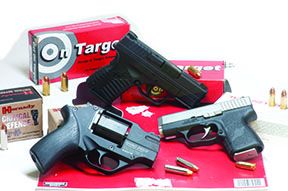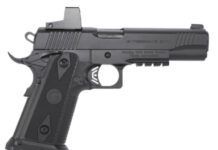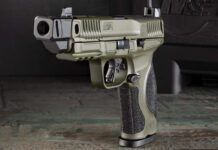Choosing a carry sidearm is a complex task for most shooters, who must weigh power and portability, size and simplicity before spending hundreds of dollars and committing to wear a gun a good chunk of the day. Pistols usually have an edge in capacity, while revolvers have a point-and-shoot ease of use that’s hard to overlook. Then there’s the issue of cartridges. How much power is enough?, and how does the consumer sift the chamberings to get the most bang for his buck?

We recently tested three guns that illustrate a range of carry choices readers had inquired about, in effect pitting McIntosh and Red Delicious apples against a Valencia orange. In gun terms, our pistols were the new Springfield XD-S 45 ACP, $599, and Kahr’s CM9 No. CM9093 9mm Luger, $382, going up against the Chiappa Rhino No. 200DS 357 Magnum revolver, $800. Those are counter prices from Fountain Firearms in Houston (FountainFirearms.us), where we acquired the guns.
What we wanted to find out, in particular, was whether the CCL holder had to sacrifice power (45 vs. 9mm) in order to get wear-all-day comfort, and whether a wheelgun, albeit an unusual one, could compete against subcompact pistols.
In fact, when you look at the basics other than action types, these three pretty much fit in the same box. The Rhino revolver is 6 inches long, about a half-inch longer than the Kahr (5.4 inches) and slightly shorter than the XD-S (6.3 inches). Height-wise, the Rhino checks in at 4.9 inches, a half inch taller than the XD-S (4.4 inches) and nearly an inch taller than the CM9 (4.0 inches).
But here’s where power factors in. The Rhino and the XD-S clearly outdistanced the CM9 in pop, so for some shooters, having the smallest footprint in the CM9 also means shooting the weakest round, which they won’t like. And, the 9mm Luger’s performance is further diminished because these short handguns won’t generate all the rated power of their respective rounds — there’s just not enough length in the barrels. Winchester’s 115-grain 9mm Luger round in the 3-inch-barrel Kahr develops average velocity/energy figures of 984 fps/247 ft.-lbs., well behind the XD-S (3.3-inch barrel, 817 fps/341 ft.-lbs.) and Rhino (2-inch barrel, 1134 fps/314 ft.-lbs.) The Fiocchi rounds showed a similar gap, except the 357 Mag was the strongest at 370 ft.-lbs., compared to 305 ft.-lbs. for the 45 ACP round and 272 ft.-lbs. for the 9mm. The power margins are little narrower for Hornady rounds because the 9mm is a +P loading, so it makes 308 ft.-lbs. of muzzle energy compared to the 45 at 360 ft.-lbs. and the 357 at 380 ft.-lbs. Also, it’s worth emphasizing that the Rhino had the highest energy ratings of the trio with two of the rounds (see the accompanying accuracy/chronograph table for details).
Besides comparing the numbers, we also tested all three for accuracy at 7 yards from a benchrest. Then we tested how each would perform when drawn and fired quickly, using Hornady Critical Defense rounds for the XDS and Rhino and Hornady Critical Duty for the CM9. For this defense test we had a target 7 yards downrange on edge, programmed to turn and face the shooter for 3 seconds, then turn back to edge, with a randomized wait time before turning. Our testers had to start from low ready and fire as many shots aiming at center mass as accurately as possible in 3 seconds. The target was a Birchwood Casey silhouette splattering target with X, 10, 9, and 8 rings.
On a gun-by-gun basis, we found some things we liked and didn’t like about each of the carry contestants. Here’s what we thought about each one individually:
Springfield XD-S 45 ACP, $599
Part of Springfield’s promotion for this pistol is the “noticeably unnoticeable” tagline, which makes sense because the slide is 0.9 inch wide and the widest part of the pistol measures only an inch. The list of features for the gun is impressive. Our test gun came in a well-padded hard-plastic case with a hard-plastic paddle holster, dual magazine pouch and Allen wrench to adjust tension on both, two 5-round magazines, interchangeable backstrap, a cable lock, wire bore brush, and extra fiber optics in both red and yellow.
The Ultra Safety Assurance (USA) Trigger System guards against accidental discharge by locking the trigger until direct rearward pressure is applied. The new XD-S trigger also has a short reset, which helped our shooter during the 3-second shooting drill.
A loaded-chamber indicator allows the shooter to verify, visually or by touch, that there is a round in the chamber. The grip safety allows firing only when the shooter has a firm grip on the pistol. The XD-S disassembles just like the XD, however, with the XD-S, the disassembly lever cannot be manipulated with a magazine in the pistol. Additionally, when the disassembly lever is up, a magazine cannot be inserted into the pistol.
A waffle-pattern grip texture wraps around the frontstrap and backstrap, providing a secure grip surface. The ability to customize the grip with two Mould-Tru Backstraps allows a variety of shooters to find the right fit, regardless of hand size. The rear sight on the XD-S is low-profile and holster friendly, and the red fiber-optic front sight was easy to find and align, our team said. A single-position Picatinny rail accepts lights, lasers or other pistol accessories. A Melonite finish protects against corrosion.
At the range, our shooters said the XD-S seemed heavy towards the front and top — to be expected with the polymer frame and steel slide. It weighs in at 22.6 ounces empty and 26.4 ounces with six 185-grain hollowpoints, which is second to the featherweight Kahr.
We liked the XDS for self defense because of the large caliber and ease of use. We performed the best in our defense test with it, firing four rounds in 3 seconds with one X, one 9, and two 8s. Our testers liked the three-dot sights, with the fiber-optic front sight, saying it was easiest to acquire the target quickly.
The advantage of this being a 45 and having more stopping power is paired with the disadvantage of the recoil of a 45 ACP in a small pistol. Our testers loved the XD-S at the start of the test, but by the end the stronger recoil had us hurting. After a day at the range, the waffle grip pattern that had provided for such a solid hold on the narrow grip had dug into our hands and left a solid impression. Concealing the XDS isn’t a problem with its small stature, although the paddle holster provided by Springfield is worn outside of the pants, so we don’t recommend it for concealed carry. We preferred a Crossbreed Minituck holster for the XDS and had no issues with concealment or drawing the weapon.
Our Team Said: For the price, we like the overall package that Springfield offers, although 45 ACP is more expensive than 9mm. Overall the Springfield XD-S ranks highly as a self-defense and concealed-carry weapon, just don’t expect to spend all day at the range with it and not have sore hands and wrists.
Kahr CM9 No. CM9093 9mm Luger, $382
The CM9 is a sub-compact, polymer-frame, semi-automatic, double-action-only, striker-fired, recoil-operated pistol chambered in 9mm Luger with a six-round-capacity magazine. The Kahr CM9 semi-automatic double-action 9mm didn’t jump out at us compared to the other pistols, but appearances and accessories aren’t everything. The CM series takes the value-priced features from Kahr’s CW series and incorporates these features into a smaller 3-inch-barrel package. The CM9093 has the same external dimensions as the PM9093, which make it ideal for concealed carry by licensed civilians and law-enforcement personnel. Differences between the CM models and the PM models are the CM has a conventional rifled barrel instead of the match-grade polygonal barrel on the PMs. The CM slide-stop lever is MIM-made instead of machined. The CM slide has fewer machining operations and uses simple engraved markings instead of roll marking. Finally, the CM series are shipped with one magazine instead of two.
The CM9 comes in a small, unassuming hard-plastic case, no protective foam or padding, just the pistol, one 6-round magazine, a trigger lock, and manuals.
Weighing in at 17.6 ounces empty, it’s a surprise to pick up, and pulling back the very stiff action and long trigger left our testers doubting how it would perform. Pulling back the slide can be difficult for some; one of our female testers couldn’t get it, and most men had to use a full grip instead of just a couple of fingers. The slide locks back after firing the last round.
The trigger pull is long and heavy, which was bothersome when shooting for fit and feel, but during the speed of the defense test, we didn’t have any problems pulling the trigger quickly. The cocking cam trigger system employs a cam to both unlock the firing-pin block (passive safety) and complete cocking and releasing of the firing pin.
The bench test surprised us when we had our best groupings with the Kahr. We still didn’t like the long trigger pull, but the results don’t lie and the CM9 had our attention. The Kahr is the only test pistol not to come with a holster, so we paired it with a Crossbreed and found that the small 9mm was easy to conceal and wear. What we didn’t like about the CM9 was the lack of safeties when compared to the XD-S. Like the Rhino, the Kahr has internal safeties, but nothing on the outside. We would feel better carrying the CM9 if it had something like the trigger or grip safety like that on the Springfield.
The offset recoil lug and the trigger-bar attachment allow Kahr’s barrel to fit lower in the frame, and because there is no hammer, the shooter’s hand is further up the grip, which should result in less felt recoil and quicker follow-up shots. Accordingly, the defense test went well for the CM9; we scored three 9s and one 8 in the 3-second window, but testers said the sights became a blur of white when drawn quickly. They said they had to hesitate and focus to be accurate. The CM9 deploys a drift-adjustable rear sight and a pinned-in polymer front sight.
Our Team Said: Overall, we were surprised by the Kahr and gave it a B+. We didn’t like the long trigger pull, lack of external safeties, and the sights became tough to see when trying to aim quickly, but the overall performance was good, and we wouldn’t be worried if we were carrying the CM9. The CM9 is a 6+1, giving it a one-round advantage over both the Rhino and the XD-S, and we like having the extra round. Pricewise, the CM9 is clearly the value pistol by a couple of hundred dollars.
Chiappa Rhino No. 200DS 357 Magnum, $800
Introduced in 2010, the Rhino is now available in 2-, 4-, 5- and 6-inch variants, in .357 Mag., 40 S&W, and 9×21. The Rhino design is the fusion of ideas from two Italians, Emilio Ghisoni, the deceased designer of the Mateba revolver, and Italian competitive shooter Antonio Caduzzo. Its unusual appearance is due largely to lowering the barrel of the revolver to the bottom chamber instead of the customary alignment with the top chamber. The idea is that by lowering the barrel in the hand, muzzle flip is reduced, allowing the shooter to execute follow-up shots with magnum rounds faster.
We started out with 38 Special to get a feel for the single-action trigger pull and grip angle. The first shot shooting supported off the bench was a surprise. Expecting some muzzle flip, we instead tracked the sights on target and were able to pull the hammer back with the off hand and fire off five more rounds quickly and accurately. Moving up to 357 Mags, we noticed a lot of report and felt recoil increased, but it was surprisingly easy to track the sights and reacquire the target. A six-shot double-action group measured 3 inches, which is respectable for any snub-nosed revolver.
Its outside appearance conceals the complexity of what’s happening inside the revolver. What looks like a hammer is actually a cocking device. The hammer in the Rhino is internal. Other revolvers with an unexposed hammer fire only in double-action, but the Rhino works in single-action or double-action mode. When you pull the lever to cock the Rhino, the lever will not move again, so Chiappa added a red cocking indicator to let you know when the gun is ready to fire. The cylinder release lays under your thumb for one-handed operation.
Another odd feature of the Chiappa Rhino is its hexagonal cylinder with flattened sides, which aid in concealment. The shape of the cylinder allows the Rhino to lay flatter against your body and prevents snagging upon drawing or reholstering. The Rhino includes a leather belt holster, so you do not have to spend the extra cash on a custom carry holster.
Some of our testers didn’t like the nontraditional grip, which requires the shooter to use a certain technique that is explained in a PDF manual on the company’s website. Having the barrel on the bottom moves everything closer to the shooter’s hands, and we did get burned on more than one occasion early in the test when we used a more traditional grip by habit.
After a full day at the range we had become more used to the grip, and felt more natural firing it. The major advantages of the relocated barrel are the linear recoil and lack of muzzle rise. Firing 357 Magnum rounds out of a 2-inch revolver all day is usually a painful experience — not so with the Rhino. We were shocked when we fired our first shot and the recoil was straight back and controlled easily, the small muzzle rise allowed us to maintain sights on the target.
One of the disadvantages of the Rhino is that the cylinder is steel (the frame is aluminum alloy), so it is just as heavy empty as the XDS is fully loaded. Also, the cylinder makes it bulky and more difficult to conceal, compared to the two flat pistols. And we had trouble quickly lining up the revolver sights, despite the fiber-optic front element. More worrisome, in our view, is that during our defense test, we fired three rounds in three seconds, scoring a 9, a no score shot to the shoulder, and a miss .25 inches from the ear. Our testers said they found the front sight quickly with the red-fiber optic, but had difficulty lining up the groove in the frame and hammer with it. Our first shot was slow, and follow-up shots were inaccurate, so we feel with a more defined or smaller groove, we could have fired quicker and more accurately. Testers also noted that their grip on the gun tended to cause them to raise the muzzle, causing most shots to be high on the target or miss completely.
There are two internal safeties in the Rhino to prevent the hammer from firing if the cylinder is not in the correct position or not closed fully, along with one to prevent mechanical interferences from creating a misfire when the trigger is not pulled.
Our Team Said: Revolvers are usually great for reliability — in the case of a failure to fire, just pull the trigger again. Unfortunately, that’s something we had to do with the Rhino three times while testing. We had three rounds, two Hornadys and one Fiocchi, fail to fire due to a hammer strike that wasn’t in the center. We like this redesign of the classic revolver, especially what it does for recoil and muzzle rise, but its weight, bulk, sights, and FTF’s made us downgrade the Rhino compared to the two pistols.





























